Gathering
An architectural intervention designed by collaborators Julia Heslop & Ed Wainwright.
Gathering: 29 September 2018 - 16 February 2019
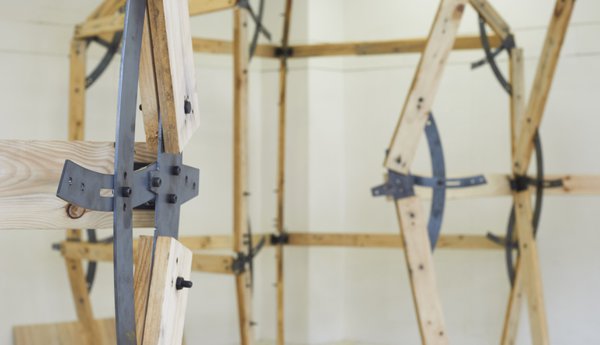
Gathering was an architectural intervention designed by collaborators Julia Heslop & Ed Wainwright to host the work of other artists, as in Kurt Schwitters’ Hannover Merz Bau, which concealed niches dedicated to his artistic heroes. Likewise, Gathering was comprised of an interconnected sequence of ‘grottoes’ assembled from found and given material, each of which was dedicated to an artist whose work deserves to be reconsidered in relation to collage as an expanded, immersive or time-based practice.
Every fortnight from when Gathering started on 29 September 2018, an invited artist or researcher dedicated a ‘grotto’ to the work of an avant-garde figure who they considered to have expanded collage towards new potential forms, with an emphasis on those whose radical practice has led to their contribution being less recognised in canonical histories of the medium.
What were those interventions?
Heather Ross

Heather Ross presented a series of prints from the Hatton Gallery Archive, belonging to the late printmaker Gwyneth Alban Davis and generated by Heather Ross's 2017 collaborative project The Caravan Press: Making visible the Archive of Gwyneth Alban Davis. Ross discussed these prints in conjunction with The Loud and the Soft Speakers - each exploring different aspects of Kurt Schwitters' experience of being in exile in Britain (1940-48).
Anka Schmid
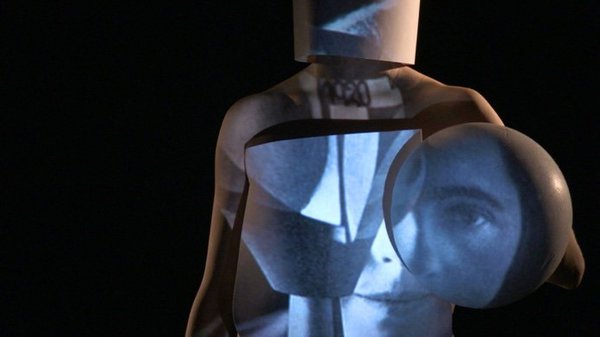
Film director, screenwriter and video artist, Anka Schmid provided her video work Sophie Dances Anyway, dedicated to Sophie Taeuber (1889-1943). Sophie Taeuber was a Swiss artist, painter, sculptor, textile designer, furniture and interior designer, architect and dancer. She is considered one of the most important artists of concrete art and geometric abstraction of the 20th century. Find out more what inspired Schmid to create Sophie Dances Anyway.
Marian Casey

Curator Marian Casey's live intervention in Gathering seeked to provide a new lens through which to examine Francis Macdonald’s (1873-1922) oeuvre.
Casey collaborated with Evan Paul English – a Brooklyn-based interdisciplinary visual and tattoo artist – who offered to tattoo a very small design based on Frances Macdonald’s work on the heel or ball of visitors’ feet. This part of the body is where tattoos are the most temporary, and the rate at which the tattoos fade differ depending on how calloused the feet of the visitor are and how much time they spend on their feet. By doing this the body and action of the visitor will participate in the collaging of Macdonald’s legacy, acting in both the reframing/restoration and the erasure of her work, as the tattoo gradually fades.
The space of the grotto has also acted as a living collage, as the designed space, the body of the curator, and the bodies of visitors all move together to push together/pull apart as a total collaged work.
Sonia Allori, Ruth Hemus, Vaia Paziana

Dada’s Women project team provided a tribute to the pioneering photomontage artist Hannah Höch. Visitors can immerse themselves in a multimedia collage of digital visuals and soundscape. The grotto has been further transformed by building, sculpting and constructing. Inspired by Höch, this communal intervention led by Vaia Paziana, Sonia Allori and Ruth Hemus aims to reminds us to ‘Never keep both feet on the ground.’
Tess Denman-Cleaver

During her intervention Tess made a multi-layered, text & voice-based performance in homage to the works of Gertrude Stein. Tess’ intervention is part of her ongoing speculative exploration of the effect that radio technology has had on language, literature, and public dialogue, and the potential for this technology as a collaging device. Elements of the performance have remained in the gallery after the event in the form of a script and audio broadcast.
The text at the heart of Tess’ performance is generated through a series of ‘cultivated motor automatism’ writing exercises, developed by Stein while she was studying medicine in the USA, before she moved to Europe. These exercises decentre the author by encouraging a writing gesture that is responsive to environmental factors including sound. Tess’ adoption of Stein’s ‘motor automatism’ writing methods are also a means by which she creates performance works through process of collage that moves between mediums, contexts and source materials.
Jackie Haynes
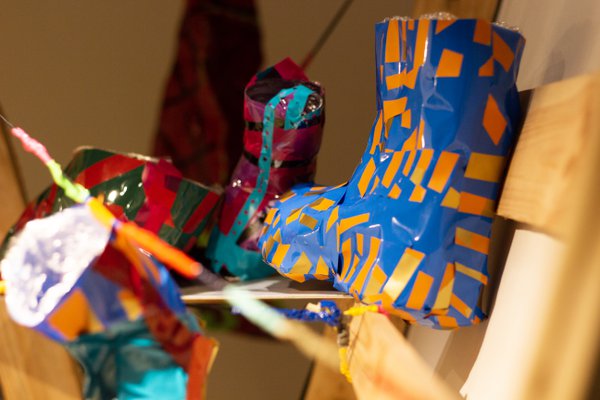
The contents of this grotto are a material resource of textual and visual references to selected literature and artwork of Mina Loy, by writers and artists, including Jackie Haynes, in addition to references to Kurt Schwitters.
The idea of the social nature and materiality seen in aspects of both Loy’s and Schwitters’ artwork, have been expanded in the grotto to explore the idea of the social nature of research. Both artists used ‘rubbish’ to make collages and the research aims to reveal further commonalities in their work. Visitors have also been annotating the reference material with their own thoughts and material responses.
‘Her poetry wasn't just excessive - it was madly in love with excess, celebrating excess as the point where poetry began. Her poems are full of textual noise: asterisks, dots, fields of whitespace, neologisms, archaisms, non sequiturs, arcane Anglo-mongrel words, dashes, capitals, carats, tildes, ready mades, foreign locutions, chatty throwaway lines, catchphrases…She writes in an exploded vocabulary, one that takes its vitality from the exploded modern city…. wearing the scars of its initiation into the world.’
(SHEFFIELD, R., 2003. Mina Loy in Too Much Too Soon: Poetry / Celebrity / Sexuality / Modernity. Literary Review, 46(4), pp. 625.)
L-INK
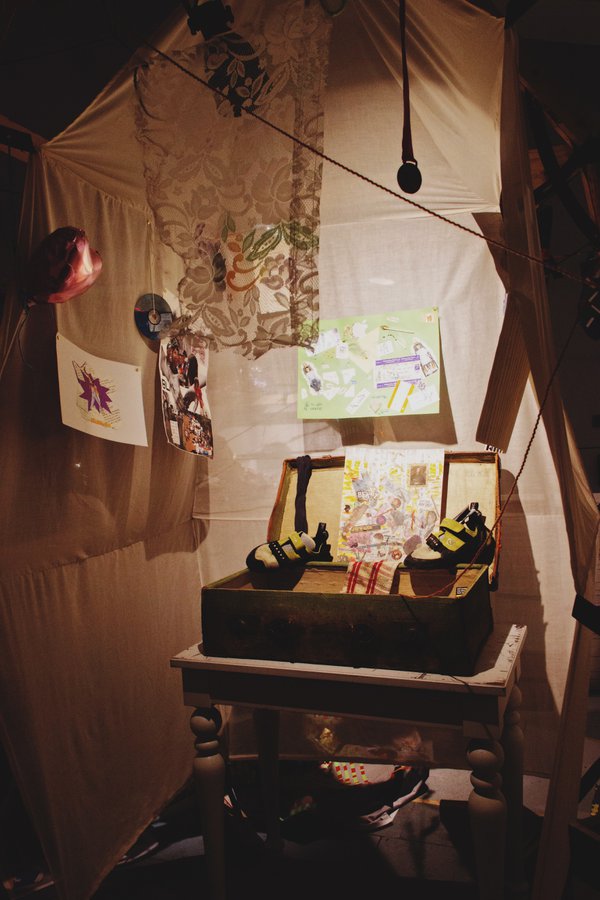
During their intervention, Young People’s group, L-INK, unpacked a suitcase of their own artworks and personal objects, each of which have connections to the theme of ‘bravery’.
This act is inspired by the life and work of Elsa von Freytag-Loringhoven (also known as ‘the Baroness’) who, as well as being an artist, poet and performer in her own right, is credited with being the first female American Dadaist, and was once arrested for wearing mens clothing, The public are invited to move, change, create, destroy or interact with the contents of the case. (An act of bravery in itself!).
L-INK 2019 are: Lucie Robson, Sara Hassan, Andrew Parr, James Barker, Jack Bray, Naomi Harrison, Charlotte Simpson & Holly Mae Robinson. Find out more about L-INK.
Mani Kambo
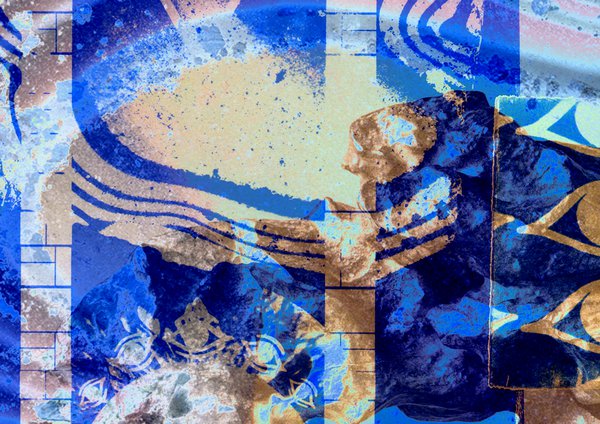
Claude Cahun once said "Under this mask, another mask; I will never finish removing all these faces"
As she explored the ‘self’ and ‘identity’, her work acts like a ‘hunt’ through her text, imagery and photography. She does not make complete artworks but rather all the different elements of her photographs and writings combine to form part of a bigger, unfinished, whole. As she creates her identity and imagery, each one becomes a new layer on top of the last, relating back to her diaristic publication Aveux Non Avenus, translated as Disavowels, which suggests that for all that is revealed and given, much is still hidden or has been lost.
Mani Kambo took inspiration from these elements, from Cahun’s practice of multiplying objects and her use of symbols and motifs such as hands within her work. Kambo abstracts these elements further, merging them with her own created imagery and art practice. In this final intervention Kambo used form, line and shape, and symbols to create new work and reflect upon the self, dream worlds and identity.



